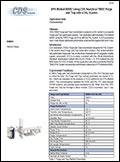Cover Story
GC–MS is considered the gold standard in forensic trace evidence analysis because of its ability to chromatographically separate and analyze components in mixtures. Although GC×GC–MS has been used extensively in the oil and petroleum and flavour and fragrance industries, it has not been fully explored in the forensic sector. read more
Features
Although modern GPC/SEC instruments are generally very reliable, scientists sometimes encounter problems. This instalment of GPC/SEC Tips & Tricks offers advice on how to efficiently identify the root cause of problems, such as dealing with a too high pressure, loss of resolution, or drifting baselines. read more
When analytical chemists apply green chemistry approaches, which seek to minimize negative environmental effects, an important area of focus is reducing the consumption of toxic solvents, such as those used in extraction steps in sample preparation. Developing and testing greener extraction processes for food analysis is a major focus of Elena Ibáñez, a research professor at the Institute of Food Science Research (CIAL-CSIC) in Madrid, Spain. read more
| |
|
News
Researchers from Postnova have used asymmetrical flow field-flow fractionation coupled to AF4-MALS to successfully characterize a polydisperse cellulose nanocrystal for size and thickness. read more
|
|
|
Application Note
 |
CDS 7000C Purge and Trap Concentrator coupled to a PAL System is a powerful Purge and Trap automation solution. This application demonstrates EPA Method 8260C using the 7000C Purge and Trap with the PAL System. A CDS proprietary type X trap shows significant performance improvement against the type K trap.
 / Read more / / Read more / |
|
|
|
|
|